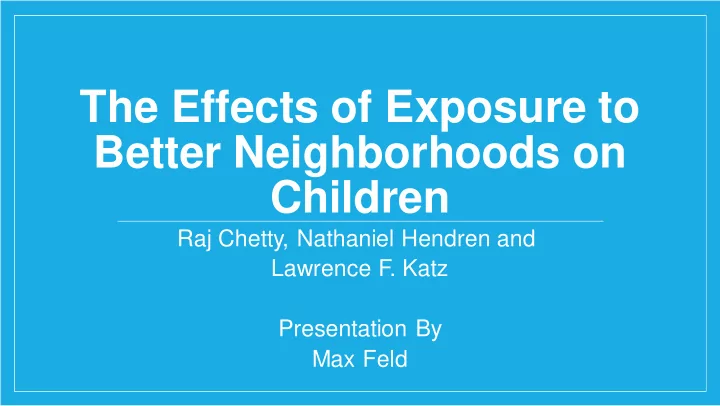

The Effects of Exposure to Better Neighborhoods on Children Raj Chetty, Nathaniel Hendren and Lawrence F. Katz Presentation By Max Feld
The Moving To Opportunity Experiment • Federal Government (HUD) experiment to test if moving to a low-poverty neighborhood has a beneficial effect on low-income families • Conducted in the 1990s with participants in Baltimore, Boston, Chicago, LA and NY
Experimental Design • Selected families in public housing located in high- poverty (40% +) census tracts were randomized into three groups: • Control group-no additional support • Partial treatment group-offered standard Section 8 vouchers • Full treatment group-offered special vouchers that can only be used in census tracts with <10 poverty
Experimental Balance and Uptake • There was only one statistically significant difference at p=.05 between treated and control groups on baseline characteristics in Chetty et al.'s analysis • Voucher usage was not universal, less than half offered the low-poverty tract vouchers used them • Those who did use vouchers-restricted or normal Section 8 moved to tracts with statistically significantly less poverty
Initial Results • Studies released in the first 10-15 years after randomization showed mixed results • Some positive gains for adult mental health and girls' education • Insignificant impacts on parents' or children's earnings and negative impacts on boys' delinquency rates
Chetty et al. Approach • Linked tax records to MTO families for follow- up after official surveys of participants ended • Examined heterogenous treatment effects for younger (below 13 at time of move) and older (13 or above) children
Key Findings • For children in the full treatment group under 13 at the time of move, there are statistically significant increases in earnings in adulthood • For children who moved 13-18, full treatment estimates are negative but not significant • Children in either age range with regular Section 8 vouchers show few significant effects
Adult Income Gains/Losses for Younger (Rising Line) and Older (Falling Line) MTO Children
Differential Age Effects are Robust to Alternatives to Splitting Over and Under 13
ITT Vs. TOT Estimates • Intention to Treat (ITT)-Results for those you select for treatment, whether or not they actually receive treatment • Treatment on the Treated (TOT)-What would the results have been if everyone received treatment? • Chetty et al. use Two Stage Least Squares (2SLS) to estimate TOT, as one would for an Instrumental Variables model
Chetty et al. Main ITT and TOT Results
Why Do Chetty et al.'s Results Differ from Earlier Studies? • As in Solon (1992), it is important when and how you measure adult incomes • Many of the younger children were too young to show income gains (which appear around age 24) when earlier evaluations were done • Looking at all children together can hide gains for those younger at move
Why Do Older Children Not Gain? • Moving to a new neighborhood may be more disruptive for adolescents • Adolescents may already have strong social networks and drift back to their old communities • Critical cognitive or social-emotional development may happen at younger ages
Why Weaker Results for Regular Section 8 Group? • Section 8 families moved to tracts with only moderately less poverty compared to full treatment group • Section 8 families often moved to tracts that were geographically closer to control neighborhoods than full treatment group
Impacts Beyond Income • Chetty et al. find significant gains for young children moving to low-poverty tracts in: • College attendance • Avoiding single parenthood • Living in lower poverty neighborhoods as adults • For older children, some college and single parenthood estimates show significantly negative effects
Moving to Intergenerational Mobility • Given significant impacts on the generation that spent only part of their childhood in low- poverty circumstances, MTO may have a more profound impact on the next generation • By inducing treated children to live in lower- poverty neighborhoods, those participants could pass the higher-mobility impact onto their children, with longer exposure to low- poverty circumstances
Policy Implications • Chetty et al. TOT estimate of increased tax payments of $11,200 is substantially higher than the $3,700 average spent on a treated family in the study • Housing vouchers may be an inexpensive tool to increase intergenerational mobility • To assure a substantial impact, voucher programs need to move recipients to significantly lower- poverty neighborhoods, preferably when children are young
Recommend
More recommend